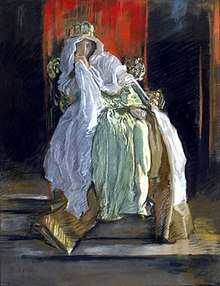The lady doth protest too much, methinks
"The lady doth protest too much, methinks" is a line from the play Hamlet by William Shakespeare. It is spoken by Queen Gertrude in response to the insincere overacting of a character in the play within a play created by Prince Hamlet to prove his uncle's guilt in the murder of his father, the King of Denmark.

The phrase is used in everyday speech to indicate doubt concerning someone's sincerity. A common misquotation places methinks first, as in "methinks the lady doth protest too much".
In Hamlet
The line, like most of Shakespeare's works, is in iambic pentameter. It is found in Act III, Scene II of Hamlet, where it is spoken by Queen Gertrude, Hamlet's mother. Hamlet believes that his father, the king, was murdered by his uncle Claudius (who then married Gertrude). Hamlet decides to stage a play, the Murder of Gonzago, that follows a similar sequence of events, in order to test whether viewing it will trigger a guilty conscience on the part of Claudius.
As Hamlet, Gertrude, Claudius and others watch the play-within-the-play, the Player Queen, representing Gertrude, declares in flowery language that she will never remarry if her husband dies.[1] Hamlet then turns to his mother and asks her, "Madam, how like you this play?", to which she replies ironically,[2] "The lady doth protest too much, methinks", meaning that the Player Queen's protestations of love and fidelity are too excessive to be believed.[1][3]
The quotation comes from the Second Quarto edition of the play. Later versions contain the simpler line, "The lady protests too much, methinks".[4][5]
Later usage
The line's allusion to Gertrude's (lack of) fidelity to her husband has become a cliché of sexually fickle womanhood[6] and a shorthand expression conveying doubt in a person's sincerity, even when the subject is male.[2] As in the play, it is commonly used to imply that someone who denies something very strongly is hiding the truth.[3] It is often shortened to "[X] protest[s] too much",[7] or misquoted with methinks at the beginning, as in "methinks the lady doth protest too much".[3][8]
See also
| Look up the lady doth protest too much, methinks in Wiktionary, the free dictionary. |
References
- Delaney, Bill (2010). "Shakespeare's HAMLET". The Explicator. 58 (2): 67–68. doi:10.1080/00144940009597010. ISSN 0014-4940.
- Garber, Marjorie (2005). Shakespeare After All. New York: Anchor. pp. 40, 467. ISBN 0-38-572214-1.
- Delahunty, Andrew; Dignen, Sheila (2012). Oxford Dictionary of Reference and Allusion. Oxford University Press. p. 238. ISBN 0-19-956746-8.
- Garber, Marjorie (2008). Profiling Shakespeare. New York: Routledge. pp. 280–281. ISBN 0-415-96445-8.
- Quassdorf, Sixta (2012). "Poetic Language Relocated". In Littlejohn, A.; Mehta, S.R. (eds.). Language Studies: Stretching the Boundaries. Cambridge Scholars Publishing. p. 171. ISBN 978-1-44-384386-7.
- Foakes, R.A. (2004). Hamlet Versus Lear: Cultural Politics and Shakespeare's Art. Cambridge University Press. p. 158. ISBN 0-52-160705-1.
- Cresswell, Julia (2007). The Cat's Pyjamas: The Penguin Book of Clichés. London, UK: Penguin Books. p. 131. ISBN 978-0-14-102516-2.
- Garner, Bryan (2016). Garner's Modern English Usage (4th ed.). Oxford University Press. p. 591. ISBN 978-0-19-049148-2.